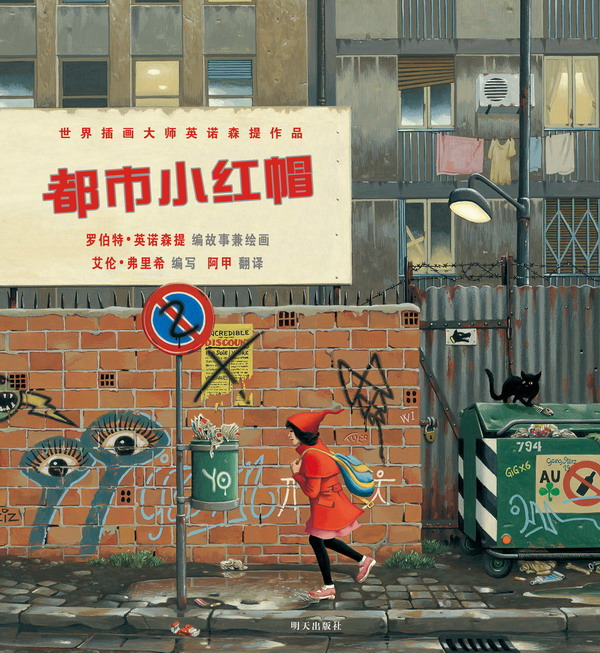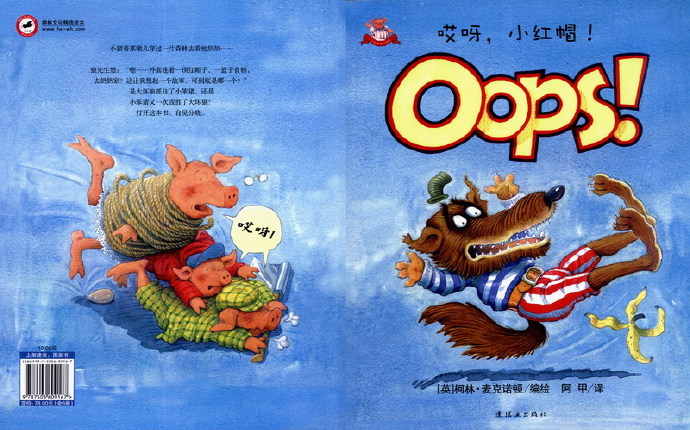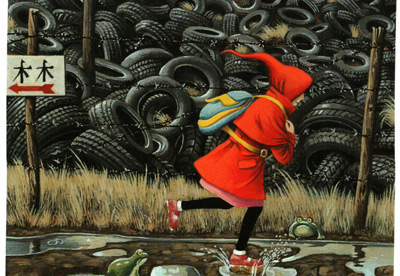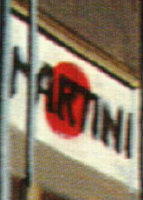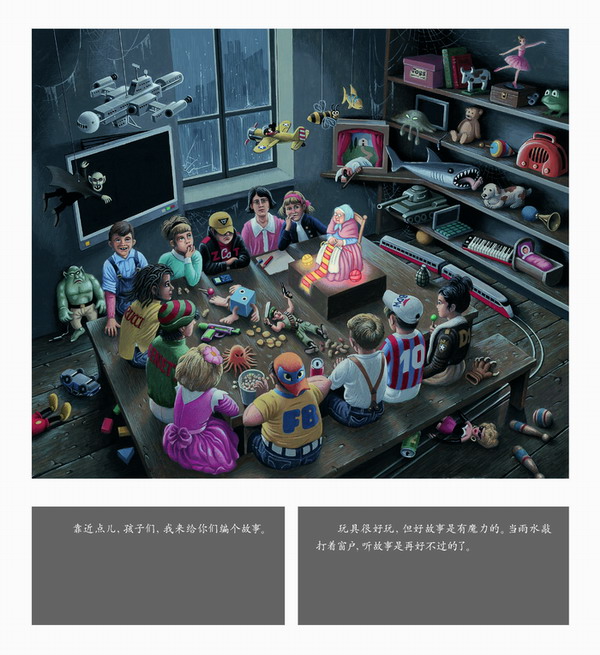You may like or dislike Innocenti’s “Urban Little Red Riding Hood”, but you have to admit that it is a masterpiece that the picture book master has poured his heart and soul into.
This is the second “Little Red Riding Hood” book I have translated.
The previous one was “Alas, Little Red Riding Hood!” by Colin MacNaughton of the United Kingdom.Oops!It’s a cheerful, if somewhat nonsensical, story: Little Pigletuner, a guest actor in a classic fairytale, dons a coat with a red hat, carries a basket of food, and journeys through the woods to visit his grandmother. The Big Bad Wolf, who’s on his trail, finds this clichéd story incredibly familiar, but can’t quite place it! When he overhears the conversation between Little Pigletuner and his grandmother, he finally realizes it’s his own line. But it’s too late to do anything evil: Daddy Pig, the guest woodcutter, arrives with an axe…
From the French writer Bellaud1697The first French edition of Little Red Riding Hood (included in Mother Goose Tales) was published in 1916.1812The German version of “Little Red Riding Hood” adapted from “Grimm’s Fairy Tales” published in 1916 continued to develop and be widely circulated. For more than three hundred years, this story has become one of the most famous fairy tales in the world. As far as I know, in terms of the richness of retellings and adaptations, “Little Red Riding Hood” should be at the top of the list.
In her book, “Little Red Riding Hood: The Evolution of a Fairy Tale Over Three Hundred Years,” American scholar Katherine Orensine traces the evolution of this classic tale, attempting to uncover the deeper meanings behind the story’s evolution through the perspectives of writers, artists, psychologists, folklorists, feminists, advertisers, filmmakers, and other social figures. Through her meticulous collection, compilation, and presentation, the image and story of Little Red Riding Hood unexpectedly become unfamiliar, imbued with a sense of novelty and excitement, even a touch of discomfort (perhaps even a hint of disgust). Yet, upon closing the book and reflecting on it, a new kind of familiarity returns, as if the lovely girl in the red hooded jacket has stepped out of a time warp, appearing so vividly within us.
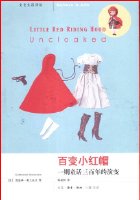
Robert Innocenti published2012The 2016 edition of Little Red Riding Hood in the City adds a new and uniquely styled member to the “ever-changing Little Red Riding Hood family,” surprising readers familiar with this classic fairy tale and somewhat surprising those familiar with Innocenti’s works. I imagine some will exclaim: Is this really a story for children?
However, what is certain is that this version of Little Red Riding Hood belongs to Innocenti. Although the text was written by American writer Alan Frisch, it is clearly stated on the cover of the book that the work of story writing and drawing was completed by Innocenti, and many stories in this picture book are told entirely in pictures.
On the surface, “Urban Little Red Riding Hood” shares structural similarities with the Brothers Grimm’s “Little Red Riding Hood,” as well as with humorous parodies like “Alas, Little Red Riding Hood!” They all appear to be meticulously paying homage to a shared tradition. The gist of it is as follows:
1The protagonist’s red hooded coat has remained unchanged for three hundred years and is usually from the grandmother’s hand;
2Little Red Riding Hood’s mission is to carry food across the forest to visit her grandmother on the other side, who lives alone in a small cottage.
3, Little Red Riding Hood was warned not to stray from the right path, and she must have violated this prohibition intentionally or unintentionally;
4, the Big Bad Wolf stalks, spies on, and even converses with Little Red Riding Hood;
5, Little Red Riding Hood told the Big Bad Wolf her mission and her grandmother’s address;
6, the big bad wolf got to grandma’s house first;
7, Little Red Riding Hood had fallen into the trap of the Big Bad Wolf when she arrived at her grandmother’s house;
8, Grandma and Little Red Riding Hood were killed one after another;
9With the unexpected help of the woodcutter, Grandma and Little Red Riding Hood were rescued, and the Big Bad Wolf got the punishment he deserved.
In fact, if you have mastered the above points, you can make up a new version of the Little Red Riding Hood story by yourself. However, please note that in the original and modern versions, the first9The first point is uncertain. At first, Belleau’s Little Red Riding Hood ended when Little Red Riding Hood was killed.1996The American film HighwayFreeway), the heroine did not wait for others, but chose to save herself.
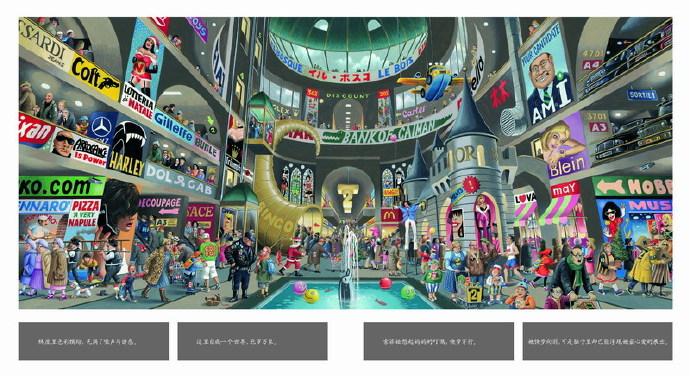
In Urban Little Red Riding Hood, Innocenti basically followed the above points, but made some special treatments:
The forest is still called a forest, but it has become a cold city of steel and concrete;
The center of the forest is still “Lin” (the
Wood), but it is a huge and bizarre shopping mall “Linzuo”, which may remind people of the shopping paradise in Florence.the Mall;
Sophie’s grandmother lives in a shack made from a used bus carriage near a scrap yard on the edge of the city forest;
Sophie lost her way while visiting the forest and ended up on a path she shouldn’t have taken, putting her in a dangerous situation.
A hunter in black rescued her, and Sophie told everything to this “good man”, who was actually the sinister Big Bad Wolf in the story;
The Big Bad Wolf arrived at Grandma’s house first, and soon Sophie arrived too. The result is obvious;
Just like in most realistic crime movies, when the police, armed to the teeth, arrive, they are always one step too late…
In order to comfort readers with nostalgic complexes, Innocenti specially arranged an alternative ending, which happened to adopt the aforementioned9The key point is: “A woodcutter sees a wolf prowling outside his cabin. He makes a phone call. The police arrive quickly, swooping down in the fading light. The wolf is captured; the family is saved…” However, this master of hyperrealism, known for his meticulous attention to detail, fails to tell us where the woodcutter came from in such a concrete city. Comparing the final, happy ending with the earlier scenes where the police’s search is in vain, the attentive reader will notice that the large signs on the buildings in the background have all vanished, as if a careless director hastily overlooked an obvious detail.
It’s just that a painter like Innocenti would never make a mistake in such details. He deliberately left this “omission”, perhaps just to tell us: such an ending, believe it or not, he himself is determined not to believe it.
If you read the story in the painting carefully, you will find that this is a painter who pays great attention to details. He has hidden many hints in the painting, and what he wants to tell here is a truly dangerous story. Here are a few examples:
Detail 1: When Sophie leaves home and walks down the stairs with her bag on her back, there is a painting on the wall to her right: a shark’s mouth with sharp teeth and a little man in it;
Detail 2: In the double-page spread of Sophie crossing the road, there is a black dog in the passenger seat of the jeep in front of her left side, but with sharp teeth and red eyes, it is clearly a wolf;
Detail 3: On the next page, Sophie is captivated by all sorts of wonders. She walks past the police, who are surrounded by a crime scene with empty bullet casings and victim marks on the ground.
Detail 4: After Sophie was “rescued” by the man in black, she went with him to the room where the motorcycle was stored. On the door was a triangular warning sign with a white background and a red border, with a line of bold capital letters below it saying “DANGER”(Danger);
Detail 5: In the series of paintings where the hunter drops Sophie off on his motorcycle, we see a trapped black dog resembling a wolf on the road Sophie passes. In the painting where she runs, a row of bullets is pointed at her in the lower left corner. Above her is a black sign of extreme danger on a yellow background. A dagger gleams on the ground. Several people sheltering from the rain appear to be mourning. The black dog barks, its teeth barked, and above her is a vicious wolf in black, galloping away…
I think these details all hint pretty definitely at a tragedy that’s about to happen.
Throughout the book, the shack where grandma lives and its background appear four times. The first three times are in the tragic story. The top of the building in the background is a striking “KING” (King’s Building), the company’s large sign reads “GOLD CO.
INC.”(Gold Co., Ltd.), look at it, it’s even more conspicuous compared to the garbage dump and miserable shacks below! But by the fourth perfect ending, in the bright sunset, these signs were gone. Can you believe it?
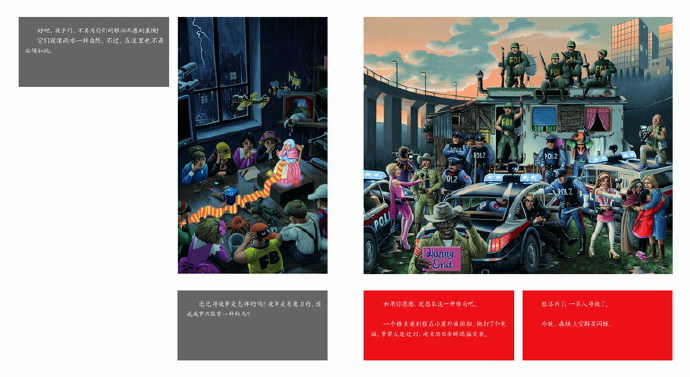
I think that this version of Little Red Riding Hood by Innocenti is not suitable for children who are too young to read.8This makes sense for readers aged 18 and above. But I think it might be easier for older readers to accept it, perhaps readers who can accept the slightly dark and scary stories of Harry Potter. Because reading this Little Red Riding Hood does require a bit of a cold and hard heart.
At this point, Innocenti’s fans may be confused: Why did this old man suddenly tell such a story?
Frankly, I can’t find much reliable background information on this new book, which was published last year. Perhaps we can ask the artist himself if we have the chance. However, you have to understand that even the artist’s own words are not necessarily trustworthy, so readers must explore it themselves.
Regarding the creative intention of “Urban Little Red Riding Hood”, I can only try to make some speculations based on Innocenti’s life and creative experience.1940The master illustrator was born in Florence, Italy in 1916. His childhood was spent in the war.13He dropped out of school at the age of 19 and went to help out in his family’s steel mill. Because he loved painting and taught himself diligently, he gradually switched to the illustration industry. After many years of hard work in this industry, he finally42At the age of 18, he co-authored his first picture book, Little Flowers on the Barbed Wire. However, it is no exaggeration to say that this debut work is already a masterpiece, which is probably the result of years of hard work.
The works of Innocenti that we are familiar with can be roughly divided into two categories: one is the collaboration with others, which includes “Flowers on the Barbed Wire”, “Star of David”, “House”, “Last Resort”, etc.; the other is the illustrations of classic works, such as “The Adventures of Pinocchio”, “A Christmas Carol”, “The Nutcracker”, “Cinderella”, etc. These are all illustrations for the classic texts of the predecessors. Even so, Innocenti still won numerous awards for his hyperrealistic illustrations with extremely exquisite details, and even2008He won the Hans Christian Andersen Award in 2002, and his achievements and reputation have reached the pinnacle of his field. He currently lives in his hometown of Florence, and should be living a carefree life.
However, for a true artist, there are still some regrets. I think the biggest regret is that he has not been able to fully express his own voice.
In the works listed above, Innocenti was already eager to experiment, constantly challenging and innovating within his pictorial narratives, powerfully articulating a distinctive voice that wrestled with the narratives of the text, creating a powerful tension that compels readers to revisit and reread. For example, even in the classic fairy tale “Cinderella,” he successfully incorporated modern and local elements, achieving a harmonious reconstruction without altering the text, a testament to his exceptional skill. However, this clearly wasn’t enough for his prolific creativity.
In his view, retelling the story of Little Red Riding Hood may be a challenge to surpass himself, and it may also be an opportunity for him to fulfill his childhood dream.
You see, he didn’t retell the story directly, but used the help of a magical old lady, who was weaving and making up the story at the same time. This kind of narration creates a little distance, so that neither the narrator nor the audience need to be too involved in it. Maybe the story is dark and dangerous, but at a safe distance.
The story is set in the present day, perhaps2010You can notice that Sophie has a younger sister who seems to have just learned to walk and is babbling, but she is already sitting in a baby chair and playing with a laptop very skillfully. The story takes place before Christmas. Santa Claus can be seen everywhere in the picture (coincidentally, he also wears a red coat and a red hat), and there are many Christmas trees. Perhaps because of the presence of Christmas trees, the city has a bit of a “forest” flavor. Especially when entering the center of the forest, there is an advertisement for a Santa Claus girl on the left, which reads “LOTTERIA
di NATALE”, which means “Christmas lottery” in Italian. Interestingly, the Santa Claus in the book looks vulgar and even a little vulgar, and the one by the pool in the center of the forest looks more like a thief (it is said that you should be wary of pickpockets when traveling and shopping in Florence).
By the way, perhaps the setting of this story is a certain aspect of Florence. The Christmases in the story don’t seem too cold, and often rain, quite like the weather in the southern coastal areas. Luxurious shopping malls and high-rise buildings are adjacent to slum-like apartments and abandoned factories. Traffic is booming but congested, and people jostle shoulder to shoulder, expressionless and indifferent to each other. In such a big city, “you have to always be listening and paying attention. Everyone can see you, but no one is looking at you.” Of course, this situation applies to many major cities, not just Florence. After all, “Firenze” also has a unique and quaint side.
Innocenti presents us with a quintessentially industrialized, materialistic metropolis, its center truly encompassing everything, with nearly every global brand represented. A closer look at the world-renowned brands featured here reveals a veritable hodgepodge, with the most striking items being: food, alcohol, lingerie, toys, adult products, cell phones, watches, cars, motorcycles, weapons…
The double page spread of the shopping mall exterior is particularly representative:THE WOOD(Linzuo), with a huge neon Christmas tree below, food and toys on the right, jeans and women’s underwear on the left, and a large spotlight on the top that looks like a sign20Century Fox Film CorporationLOGOIn the near distance there is congested traffic and filth all over the ground, in the distance there are tall buildings, and on the left side, just across the wall, there is an apartment building that looks to be abandoned (if it were in China, there might be a big word “demolition” on it).
Eating, drinking, playing, sex, violence, luxury, poverty, extravagance, filth, insatiable desires, pervasive media, and politics mixed in… This is the “urban hodgepodge” that Innocenti prepared for us, which can also be given the beautiful name of “urban cultural landscape.”
By the way, speaking of politics, is there really any politics in this book? Of course not. Please look at the huge advertisement on the upper right side of the Linzuo Hall. Just to the right of the bright red word “Lin”, there is a photo of a person on a blue background with the words “YOUR
CANDIDATE AM I”(I am your candidate). What particularly intrigued me was what kind of person could hang his campaign ad next to the sign of a shopping center? And the more I looked at him, the more I thought this guy looked quite Japanese.
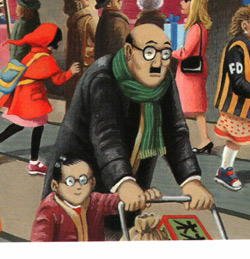
In this large double-page spread, there are several Japanese cultural symbols, such as the father and son in the lower right corner who look quite typical Japanese; there is a line of katakana in the upper center of the picture “ィル·ボスコ”, most likely a famous Italian wine brand“IL BOSCOThe Japanese name of the brand with the English name actually appeared on the page where Sophie was crossing the road, next to the traffic light and on the road sign on the left; the most hidden one was the one on the women’s underwear brandTriumph(Triumph) The famous Italian wine on the rightMartini(Martini) brand advertisement, at first glance it looks like MartiniLOGOHowever, a closer look reveals that it is actually a replica, with a pattern closer to the Japanese flag. It’s difficult to guess Innocenti’s true intentions. However, it’s worth noting that “林” (Lin) is a Chinese character, and also a Japanese character, meaning the same thing.
If the blue-background portrait campaign ad only appeared once, it would probably be a coincidence. But keep turning the page and you will see it twice more: once in the background when the men in black “rescue” Sophie, and after the lightning, you can see a large billboard with a portrait that looks like a mafia figure, and next to it is a big letter “I AM THE
BEST”(I am the best); one is a picture of a man in black riding a motorcycle and answering a phone call. In the background is a high-voltage power line tower in the distance. The man in the advertisement is wearing a scarf and looks kind. He stretches out his fingers to sign “I love you”. The text next to it is incomplete“LIB…“Suspected to be “freedom” or something like that. The following two political ads seem to be tied into the development of the plot. But the combined impression of all three ads is a kind of inexplicable bluffing, which, mixed in with the tempting ads of “food, sex and human nature”, is a kind of harmony.
Throughout, Innocenti never expressed his own opinions or evaluations. I imagine if someone had asked him, he might have said that the painter’s mission was simply to record. However, through such a sharp perspective, can’t readers still grasp his critical intent?
Some might worry: Is this view of the world safe for children to see? Is this grim story safe for children to hear? This is indeed a question.
Please turn to the first page, where the magical old woman begins her story, and look at the toys children today are playing with. Yes, they shed tears when they hear this version of Little Red Riding Hood, proving they are still children, with tender hearts deep down. But have you ever noticed? What toys do they play with? What programs and stories do they encounter in the media? What kind of world do they see as they walk down the street or into the shopping mall? Today’s children, like us adults whose hearts have become quite hardened and numb, live in this hodgepodge of “eating, drinking, playing, sex, violence, luxury, poverty, extravagance, filth, insatiable desires, the pervasive media, and the politics that are mixed in…” Isn’t that right?
Pay special attention to the scene where Sophie gazes at her toys in the “magic window.” “Before her, there were monsters, princesses, doom, and ‘they lived happily ever after.’ ” Sophie gazes intently at the iconic Little Red Riding Hood. She’s not disobeying her mother’s warning; she simply can’t resist picking a flower from the forest, a pure daisy. Can a girl who loves beauty resist such an innocent temptation? This is the real Little Red Riding Hood, perhaps the beautiful and pure girl Innocentes dreamed of in his childhood. No matter how the world changes, she still believes in the fairy tale’s promise of eternal happiness.
But the world has truly changed. Look at all the dolls and toys surrounding Little Red Riding Hood: weapons from land, sea, and air, terrifying militants, savage and bloody monsters, voluptuous women of the night, especially the one below, clad in red lingerie, wielding twin guns, a sultry and fierce figure… Yes, this is the imaginary world in which today’s children often immerse themselves. Remember, today, before they’re even a year old, they’re already playing exciting games on tablets and phones. And yet, we adults still struggle in vain: Do we dare tell children about this Little Red Riding Hood?
Well, let’s get back to the world of stories. Toys are fun, but good stories are magical.
Stories are like the sky… Help children learn to look up at the sky.
Ajia … Written on2013Year9moonBeijing
